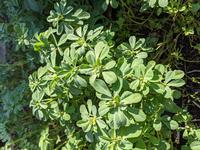Fenugreek
Fenugreek, Trigonella foenum-graecum, is one of the oldest cultivated medicinal plants. Its exact origin is unknown, but it is believed to be native to Southern Europe and Asia. The green parts of the plant are mildly bitter and typically cooked as a vegetable, or dried and used in many versions of spice mixes. The seeds, roasted or raw, are ground and used as a condiment. In some locations, fenugreek is grown for livestock fodder. Being a leguminous plant, fenugreek enriches the soil with nitrogen.
How to grow
- Type: Annual
- Light: Full sun
- Soil: Well amended soil, good drainage
- Water: Low to moderate; do not overwater
- Size: 12–24" high x 12–24" wide
When to plant/propagate
Fenugreek is grown as a cool-season herb and will start to go to seed with the warming spring temperatures.
- From seed: Direct seed in late summer
- Transplants: Fenugreek may also be planted from grocery store plants that still have the roots attached
Harvesting
- Harvest young shoots and leaves for use as a vegetable. Dry the green portions for spice mixes.
- For seeds, allow the plants to regrow and flowers to develop
- Preserving and drying herbs
Indoors: Fenugreek can be grown as an indoor plant
More information
- Trigonella foenum-graecum, North Carolina State Extension
- Fenugreek, PlantVillage, Penn State University College of Agricultural Sciences







